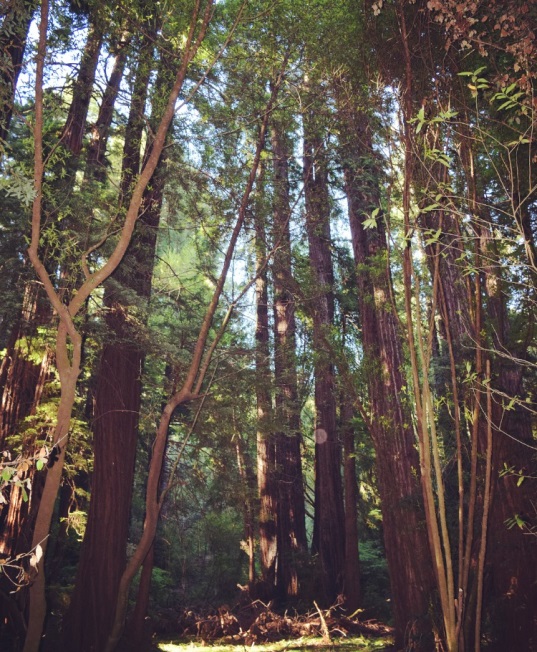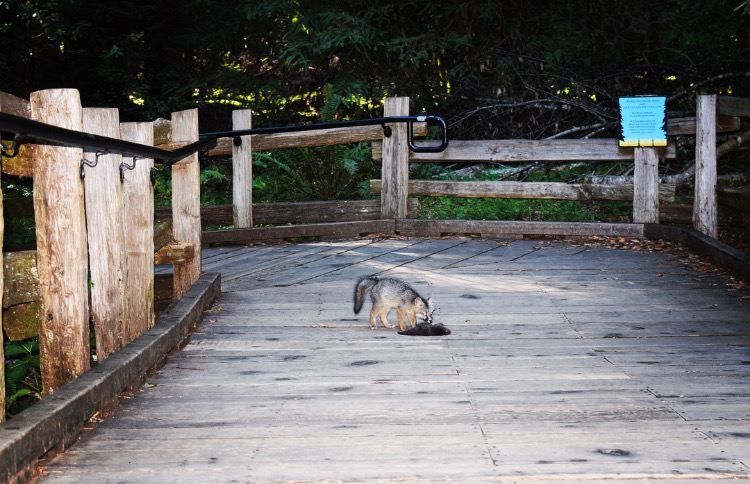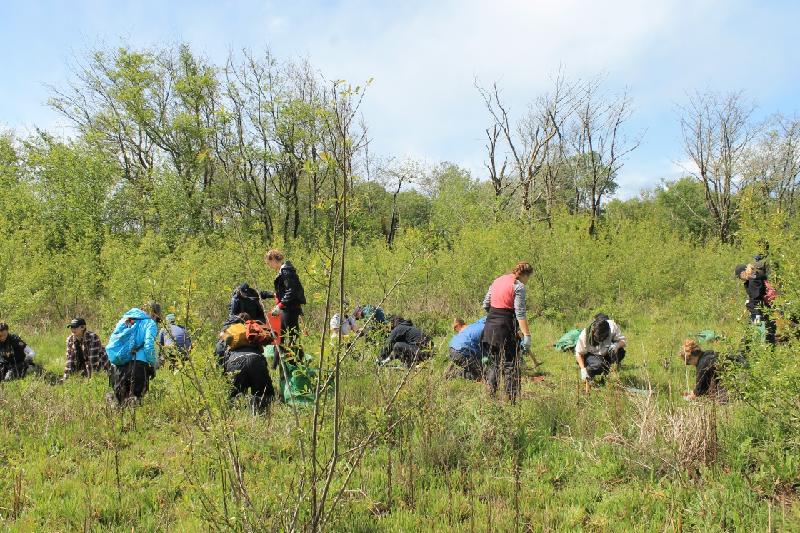|
It’s Summertime in the Parks!
Marin Park Stewardship's August 2017 Newsletter
|
Dear Friend,
We hope you are enjoying the foggy warmth that August brings to the Bay Area. It’s a great time to go on early morning hikes around Marin to get beautiful views of fog layers drifting through the hillsides, over the bay, and above the redwood forest canopies.
In This Newsletter
Everything You’ve Ever Wanted to Know About Redwood Trees…and Then Some!
By Chelsye Knight
Summer is almost over but the summer heat is still on the rise. If you are looking for a place to cool off, I would suggest going to a redwood forest. If you do decide to venture into a forest, here are some cool (pun intended) facts you can take along with you and impress your family and friends.
The coast redwood tree (Sequoia sempervirens) is the tallest—and amongst the oldest—living organisms in the world. Some of the tallest individuals reach close to 400 feet and are over 2,000 years old!
Coast redwoods can reproduce in two ways: sexually and asexually. For sexual reproduction, the redwood tree produces two kinds of cones (female and male), one containing the seeds and the other the pollen. Their cones are very small, about 1 inch wide and long, and each seed is about the size of a tomato seed.
Asexual reproduction is a type of reproduction through which offspring arise from a single organism, and inherit the genes of that parent only. Redwood trees produce burls, a structure that grows on the tree and also can be found in the root system.
A redwood tree will produce a burl if it is under stress. If the tree’s survival comes under threat, the burl will release clone spores, each identical to the parent tree.Given the height of the redwood trees, one would think their roots reach insane depths in order to support their massive structure. Actually, their roots only reach depths of about 6-12 feet.
In order to remain stable they have to rely on each other and intertwine their roots, forming what is called a family circle. Their roots may be shallow but they can reach in all directions about 40-60 feet, enabling them to grab hold of their neighboring trees’ roots.

|
A family circle of redwood trees in Muir Woods.
Photo by Rebecca Natoli |
Coast redwoods have remarkable physical characteristics that enable them to thrive in their habitat. Their bark (which can be up to 12 inches thick) contains a special acid called tannic acid; this protects the tree in a number of ways. First, it works as a natural insect repellant; tannic acid has a very bitter taste. Secondly, tannic acid helps to prevent mosses, fungus, and most species of lichen from growing on the tree. This is incredibly beneficial for the wellbeing of the tree because it helps prevent diseases.
Lastly, tannic acid works as a fire suppressant. Most people believe fire is bad for a forest; in truth, fire can be quite beneficial to a forest. It removes all of the dead plant material (duff) covering the forest floor and allows redwood seeds to reach the soil.
These mighty organisms seem indestructible, but they do have forces acting against them—humans, wind, and climate change. Since the Gold Rush of 1849 the population of California has been exponentially growing, which has led to the destruction of 97% of all the old-growth redwood forests.
Due to the redwoods’ shallow roots, they are highly susceptible to falling during high wind storms. Family circles do give added support, but sometimes it just isn’t enough. Climate change has reduced the fog line by 33% as of 2013, which is a direct correlation to habitat reduction of the redwoods. Redwood trees love water; depending on their size, a tree can suck up 200-500 gallons of water a day and they get about 50% of their water directly from fog.

Redwood forests also provide habitat to a wide array of wildlife. Muir Woods National Monument hosted a family of grey fox (Urocyon cinereoargenteus) this spring! Here is a photo of a young fox showing off its new hunting skills. While these animals are very cute, it’s important to remember that they are wild and depend on honing their wild behaviors in order to survive. Therefore it is important that park visitors admire these animals from an appropriate distance. Photo by Rebecca Natoli.
In addition to Muir Woods, there are several nearby locations that will also allow you to bask in the wonder of these ancient trees. Here is a listing of a few other beautiful coast redwood groves that may provide an escape from the summer crowds (and crowded parking lots) at Muir Woods.
- Samuel P. Taylor State Park (Point Reyes)
- Redwood Regional Park (East Bay)
- Armstrong Redwoods State Natural Reserve (Sonoma County)
- Big Basin Redwoods State Park (Santa Cruz County)
Marin Volunteer Program Information and Work Day Schedules
Marin Park
Stewardship
Saturdays, 10 am–1 pm, and Wednesdays, 1–4 pm
We alternate between sites, so check the details for each work day. Work day events include a combination of hands-on service and short natural or cultural history lessons.
Click here to
learn more or sign up.
Wednesday Programs 1–4 pm
August 16 Alta Avenue
August 23 Muir Beach
September 13 Muir Beach
September 20 Wolfback Ridge
Saturday Programs 10 am–1 pm
August 12 Muir Beach
August 19 Alta Avenue
August 26 Muir Beach
September 16 Muir Beach Coastal Cleanup Day
Meeting Locations and
Directions
Muir Beach – Meet
at the parking lot picnic tables. Map
Alta Avenue at Oakwood Valley – Meet at the park gate located at the end of
Donahue Street. Map
Wolfback Ridge – Take
a right on Bunker Road (immediately before the tunnel). Park in the lot by the
bus shelter behind the Marin Headlands sign, only in a designated parking spot
(not along the road). We will meet in the parking lot. Map
Marin Headlands Nursery
Wednesdays, 1–4 pm
1st and 3rd Tuesday of every month, 10 am–2 pm
Come grow with us at the Marin Headlands Nursery! Each year, we grow over 30,000 plants to restore natural habitats within the Marin Headlands. The dedication and support of our volunteers are vital in the effort to grow plants, collect seeds, maintain the nursery facility, and much more. Our projects are outdoors, fun, and always hands-on.
For program updates and registration, click here.
Habitat Restoration Team
2nd and 4th Tuesdays, 10 am–2 pm
Sundays at 9:30 am–2:30 pm
Help restore and monitor critical natural areas from the Marin Headlands to Bolinas Ridge. Volunteers and staff meet at different scenic locations each week to restore native habitat throughout the Golden Gate National Parks. Come out and explore beautiful areas while assisting in invasive plant removal, winter planting, and seed collection. For more information,
click here.
Invasive Plant
Patrol
Wednesdays, 10 am–2:30 pm
An ounce of prevention is worth a pound of cure. Invasive Plant Patrol volunteers hike throughout the Marin Headlands to find new invasions of exotics and remove localized infestations before they get out of control. Get to know the park trail systems and learn to identify plants, both native and invasive. Hikes will last approximately four hours. Locations vary from the Marin Headlands to Bolinas Ridge. For locations and to register, click
here.
 |
Marin Park Stewardship has had a busy summer doing restoration with amazing summer youth groups from Aim High and the YMCA.
Photo by Rebecca Natoli
|
Thank you for supporting the Golden Gate National Parks Conservancy!
-Marin Park Stewardship

|